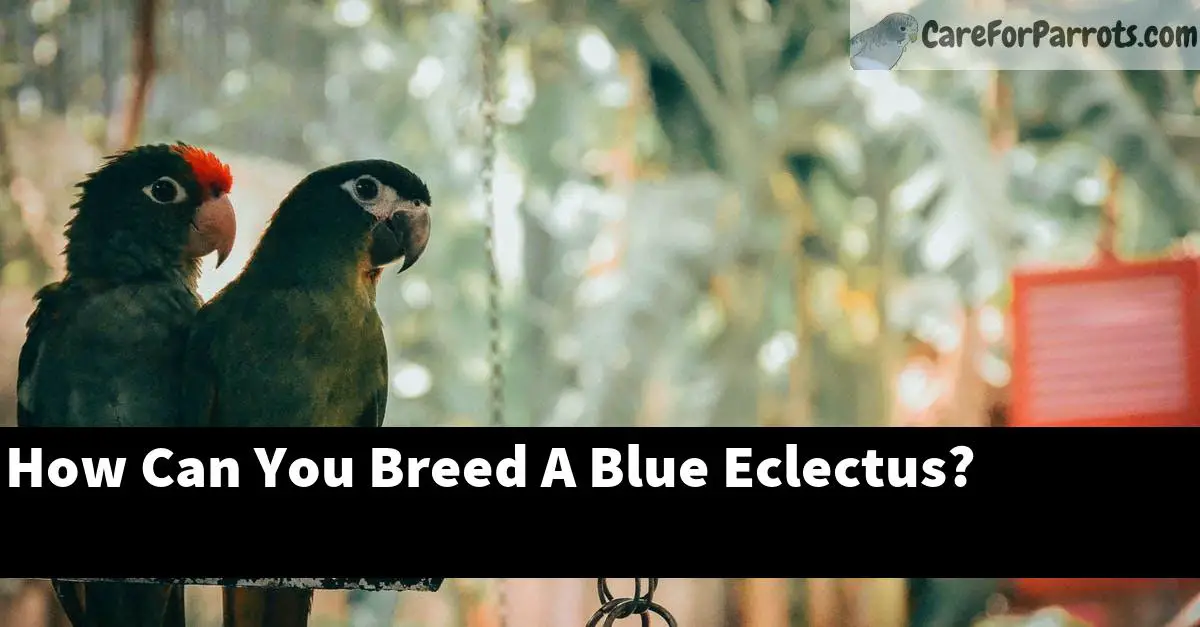Breeding the exquisite Blue Eclectus parrot is an exciting endeavor for bird enthusiasts and breeders alike. These rare and stunning parrots have captured the hearts of many with their vibrant plumage and captivating personalities.
In this article, we’ll explore the necessary steps to successfully breed Blue Eclectus parrots, including understanding their unique needs and providing the right environment for successful breeding.
If you’ve ever wondered what it takes to produce these beautiful birds, you’ve come to the right place.
We’ll discuss everything you need to know, from selecting the right breeding pair to nurturing the hatchlings into healthy, thriving adults. So, without further ado, let’s dive into the fascinating world of Blue Eclectus breeding.
Table of Contents
Selecting the Right Breeding Pair
Physical Characteristics
When choosing a suitable breeding pair, it’s important to consider the physical attributes of both the male and female. A healthy pair should have bright and shiny plumage, clear eyes, and an overall alert and active demeanor. Additionally, look for signs of good genetic traits, such as strong beaks and well-formed feet.
Age and Maturity
Age and maturity play a crucial role in breeding success. It’s recommended to start breeding Blue Eclectus parrots when they are around 4 to 6 years old. At this age, they are sexually mature and more likely to produce healthy offspring.
Setting Up the Breeding Environment
Choosing the Right Enclosure
Providing a comfortable and secure environment for your breeding pair is essential. An appropriately sized aviary or flight cage should offer ample space for the birds to move around freely, with separate areas for feeding, resting, and nesting.
Nesting Materials
To encourage nesting behaviors, provide an assortment of nesting materials, such as wood shavings, shredded paper, and natural fibers. Make sure the materials are non-toxic and safe for the birds to use.
Temperature and Humidity Control
Maintaining the correct temperature and humidity levels is crucial for successful breeding. The ideal temperature range for Blue Eclectus parrots is between 72-82°F (22-28°C), while the humidity should be kept at around 50-70%.
Diet and Nutrition for Breeding Pairs
Nutrient Requirements
A balanced and nutritious diet is essential for promoting overall health and fertility in your breeding pair. Offer a combination of high-quality pellets, fresh fruits, vegetables, and protein sources such as cooked eggs or lean meat.
Supplements
To further support the breeding process, consider providing supplements that cater to the specific needs of breeding birds. These may include additional calcium, vitamins, and minerals to promote healthy egg production and chick development.
Monitoring the Breeding Process
Recognizing Mating Behavior
Keep a close eye on your breeding pair to observe signs of mating behavior. This may include courtship displays, such as the male performing a dance or vocalizing to attract the female’s attention.
Matiniy 2 Pcs Pirate Parrot on Shoulder Life Sized Artificial Parrot Toy for Costume Dress-up Accessory for Halloween Party(Multicolor)
$13.99 (as of 10/06/2025 21:14 GMT +03:00 - More infoProduct prices and availability are accurate as of the date/time indicated and are subject to change. Any price and availability information displayed on [relevant Amazon Site(s), as applicable] at the time of purchase will apply to the purchase of this product.)BBjinronjy Large Parrot Toys Bird Chewing Toys-Natural Nuts Corn Loofah Wooden Bird Cage Toy for African Grey,Macaws,Conure,Cokatoos,Cockatiel,Amazon Parrots and Other Medium and Small Birds
$12.99 (as of 10/06/2025 21:14 GMT +03:00 - More infoProduct prices and availability are accurate as of the date/time indicated and are subject to change. Any price and availability information displayed on [relevant Amazon Site(s), as applicable] at the time of purchase will apply to the purchase of this product.)Vitakraft Fresh Super Fruit Cocktail - Tropical Parrot Fruit Blend - Parrot and Parakeet Treats Browns 1.25 Pound (Pack of 1)
$11.99 ($9.59 / lb) (as of 10/06/2025 21:17 GMT +03:00 - More infoProduct prices and availability are accurate as of the date/time indicated and are subject to change. Any price and availability information displayed on [relevant Amazon Site(s), as applicable] at the time of purchase will apply to the purchase of this product.)Ensuring Fertility
If you suspect infertility, consult an avian veterinarian for guidance. They may recommend tests to determine the underlying cause and suggest possible treatment options.
Caring for Eggs and Hatchlings
Incubation
Once eggs have been laid, it’s important to ensure they are incubated at the correct temperature and humidity levels. In most cases, the female Blue Eclectus will tend to the eggs, but you may need to intervene with an artificial incubator if necessary.
Feeding and Growth
Upon hatching, the chicks will require constant care and feeding. Offer a specially formulated hand-rearing formula, gradually transitioning to a solid diet as they grow and develop. Monitor their growth and weight closely to ensure they are receiving adequate nutrition.
Socialization
Introducing your young Blue Eclectus parrots to various stimuli and social situations is essential for their overall development. This includes handling them regularly and exposing them to different sights, sounds, and experiences to help build their confidence and adaptability.
Health and Well-Being of Your Breeding Pair and Offspring
Regular Veterinary Checkups
To maintain the health and well-being of your breeding pair and their offspring, schedule regular veterinary checkups. This will allow you to detect and address any potential health issues early, ensuring the overall success of your breeding program.
Preventative Care
Implementing a preventative care routine is essential in maintaining the health of your Blue Eclectus parrots. This includes keeping their environment clean, providing a balanced diet, and monitoring for any signs of illness or distress.
Conclusion
Breeding Blue Eclectus parrots is a rewarding experience that requires dedication, patience, and attention to detail. By following the guidelines outlined in this article, you’ll be well on your way to successfully breeding these magnificent birds and contributing to the preservation of their unique and captivating species.
FAQ
Q: How long does it take for Blue Eclectus eggs to hatch?
A: Blue Eclectus eggs typically take around 28 to 30 days to hatch. It’s essential to maintain the proper temperature and humidity levels during this period to ensure successful hatching.
Q: How many eggs do Blue Eclectus parrots lay at a time?
A: Female Blue Eclectus parrots typically lay a clutch of 2 to 3 eggs, although this can vary depending on the individual bird and the conditions provided.
Q: How often can Blue Eclectus parrots breed?
A: Blue Eclectus parrots can breed multiple times a year, but it’s important to give them a rest period between breeding attempts to ensure their overall health and well-being.
Q: What should I do if my Blue Eclectus parrots are not mating?
A: If your Blue Eclectus parrots are not mating, it’s important to review their environment, diet, and overall health. Consult an avian veterinarian for guidance on improving breeding conditions and addressing any potential issues.
Q: Can Blue Eclectus parrots be bred with other Eclectus species?
A: While it is technically possible for Blue Eclectus parrots to breed with other Eclectus species, it is not recommended. Interspecies breeding can result in genetic issues and may harm the integrity of the Blue Eclectus bloodline.























